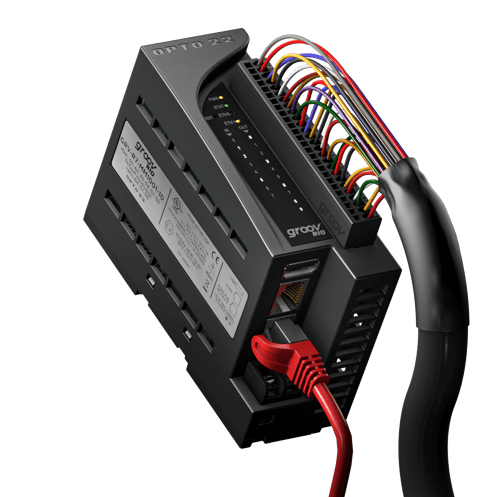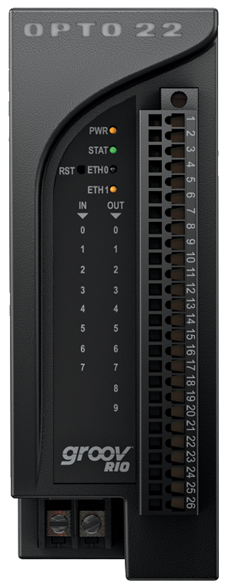One part number.
Thousands of Unique Field I/O Combinations.
That's RIO cool.

The groov RIO family launched with GRV-R7-MM1001-10 as the first in a new class of intelligent, distributed I/O for the IIoT. The MM1 was followed by GRV-R7-MM2001-10, which includes Ignition Edge and offers more memory and storage.
Both of these groov RIO models are universal I/O, providing 8 channels configurable for analog or discrete inputs or outputs, plus 2 Form C mechanical relays for higher loads.
Designing these two RIO models to democratize I/O data, we built so much into one device—super-flexible I/O channels, multiple installation options, and embedded software for retrieving, processing, and transmitting data—that it takes some work to understand the full range of functions they provide.
Thousands of I/O combinations is a big claim, though. Just how did we come up with that?
Doing the math
 To begin with, GRV-R7-MM1001-10 and GRV-R7-MM2001-10 each offer 10 software-configurable channels. That means no DIP switches or jumpers. It’s all done through the browser-based groov Manage interface.
To begin with, GRV-R7-MM1001-10 and GRV-R7-MM2001-10 each offer 10 software-configurable channels. That means no DIP switches or jumpers. It’s all done through the browser-based groov Manage interface.
The math starts when you consider that each of the first eight channels supports multiple I/O signal types and functions:
- Channels 0-3 support 10 different kinds of I/O circuits: analog input sensing (V/mV/mA/Ohms*), temperature input sensing (ICTD/TC/thermistor), simple discrete input sensing, powered switch discrete input sensing, and discrete output control.
- Channels 4-7 support 9 different kinds of I/O circuits: analog input sensing (V/Ohms), temperature input sensing (ICTD/thermistor*), simple discrete input sensing, powered switch discrete input sensing, analog output control (V/mA), and discrete output control.
- Channels 8 and 9 are Form C relays, so they support either normally-open or normally-closed loops.
Simple combinatorial logic (10 x 10 x 10 x 10 x 9 x 9 x 9 x 9 x 2 x 2) tells us this would support 262,440,000 different sequences of I/O signals. Not every one of those combinations is valid, of course, and after filtering those out, the number comes down to 236,878,344. Clearly, that’s still a lot, but in practice, it doesn’t mean much.
*NOTE: Thermistor/resistor support requires
groov RIO firmware 3.0 or higher.
What really counts?
From the perspective of the instrumentation tech or control systems engineer in the field, it doesn’t matter how many ways you can order a series of wires. What you want to know is whether there is a place on the module in front of you to land those wires you’re holding.
To answer that question, we had to figure out how many of those 236M+ combinations were functionally unique, regardless of signal ordering.
This Python script builds a list of all the possible combinations, sorts the I/O signals included in each one, and then filters out any duplicate configurations, leaving us with a non-repeating list of permutations adding up to 203,607.

This means that GRV-R7-MM1001-10 will accept over 200,000 different combinations of 10 signals. Can you find a place to land those wires you’re holding? YES! If there’s a spare channel available, then chances are you can configure it for what you need.
Need 7 voltage inputs and just 1 DI? No problem. You can handle that all with one groov RIO unit. How about 2 TCs, 3 voltage inputs, 1 DI, and 2 DOs? Sure, groov RIO can handle that too.
Think about what this flexibility does for front-end engineering and spares management. Only one part number to specify. Only one part number to stock.
Adding more I/O to the system? No problem! Just install another RIO, connect it to a PoE network switch, providing power and connectivity simultaneously, then configure the channels for whatever signals you need.
But wait! There’s more...
This calculation only considers the I/O options. We had to stop there, of course, because if you factor in every feature included in GRV-R7-MM1001-10, the numbers get too unbelievable.
If you factor all 7 supported TC types into the calculation, you get hundreds of thousands of unique combinations. If you include the fact that each channel provides intelligent signal processing features, like scaling, ramping, counting, and totalization, the possible configurations are astronomical. You could do the math, though. We won’t stop you… ;-)
What would you like to do with groov RIO?
To see this flexibility in action, check out the groov RIO Explorer.
See the groov RIO Universal Edge I/O data sheet.
Download the groov RIO Universal I/O product brochure or the groov RIO Energy Monitoring Unit brochure.
Get groov RIO now!
| Part Number |
|
Description |
| GRV-R7-MM1001-10 |
- |
groov RIO MM1 universal edge I/O, 8 multifunction signals, 2 Form C relays, no Ignition |
| GRV-R7-MM2001-10 |
- |
groov RIO MM2 universal edge I/O, 8 multifunction signals, 2 Form C relays, expanded memory, Ignition Edge 8 pre-installed |
| GRV-R7-I1VAPM-3 |
- |
groov RIO EMU, energy monitoring edge I/O module, 64 channels of power and energy data |
For additional information and application advice, contact an Opto 22 pre-sales engineer: 951-695-3000 or toll-free, 800-321-6786.